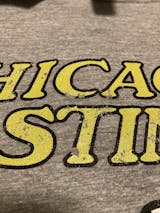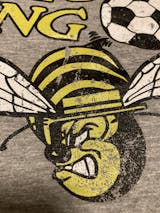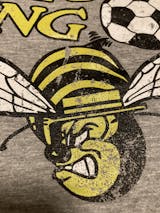There was a neat web series on NFL.com a few years back called The N “if” L. It was produced by NFL.com analyst Dave Demeshek. Each episode offered different scenarios based on a particular event in league history. There’s a great one for Cleveland fans called “What if ‘The Drive’ had Stalled?"
A favorite among devotees of the defunct, though, is from 2012 called “What if the USFL Hadn’t Folded?” It’s interesting and pretty funny, but as aficionados of defunct leagues, it got us thinking.
We decided to take a hard look at the premise, and here’s what we came up with.
In Demeshek’s universe, the USFL survives and moves to the fall, which it had planned to do in 1986. He points out accurately that the USFL had a lot of big stars, but he incorrectly states the league had a lot of cash. Some teams did, most did not, though they weren’t swimming in red ink like some of the teams that wound up folding or almost all of the teams from the World Football League of the mid-70s.
Demeshek’s surviving USFL:
East
Baltimore Stars
Birmingham Stallions
Jacksonville Bulls
New Jersey Generals
Orlando Renegades
West
Arizona Wranglers*
Memphis Showboats
Oakland Invaders
Portland Breakers
San Antonio Gunslingers
*We added Arizona because Demeshek only pulls nine names out of his USFL pog box in the video, and Arizona was one of the healthier franchises.
The problem with this lineup is San Antonio and Portland were both broke. Oakland, even with the addition of a bunch of talented players from the Michigan Panthers, saw attendance plummet. For the record, the original fall configuration for the USFL was to be as follows:
USFL 1986 (proposed)
Liberty Division
Baltimore Stars
Birmingham Stallions
Memphis Showboats
New Jersey Generals
Independence Division
Arizona Outlaws
Jacksonville Bulls
Orlando Renegades
Tampa Bay Bandits
Many of the teams that played in the spring of 1985 either folded or merged instead of moving to fall. As early as 1984, when the move to fall was announced, teams were moving, folding, or merging with other teams. This was the USFL in 1984 before the decision was made to move to fall.
USFL 1984:
Atlantic Division
New Jersey Generals
Philadelphia Stars
Pittsburgh Maulers
Washington Federals
Central Division
Chicago Blitz
Houston Gamblers
Michigan Panthers
Oklahoma Outlaws
San Antonio Gunslingers
Southern Division
Birmingham Stallions
Jacksonville Bulls
Memphis Showboats
New Orleans Breakers
Tampa Bay Bandits
Pacific Division
Arizona Wranglers
Denver Gold
Los Angeles Express
Oakland Invaders
Under our thesis, the USFL survives because it does not move to fall, despite Donald Trump’s insistence. Demeshek, by the way, alludes to the widely accepted belief that Trump killed the USFL.
Yes, if you have to point to an individual, the former president is probably your guy. However, he had a lot of help, most notably from Eddie Einhorn, who planned on placing a new team in Chicago at some point to replace the Blitz.
Einhorn was no stranger to rebel leagues. In the 1970s, he headed up TVS, a syndicated sports network that carried World Football League games. It’s not unreasonable to assume that Einhorn initially convinced Trump that a move to fall, and a possible merger, was the way to go.
So here is what the USFL probably would have looked like in the spring of 1985, had the league not announced a move to fall play for the 1986 season.
1985 (Spring without fall move)
Atlantic Division
New Jersey Generals
Philadelphia Stars
Pittsburgh Maulers
Orlando Renegades
Central Division
Memphis Showboats
Houston Gamblers
Michigan Panthers
San Antonio Gunslingers
Southern Division
Birmingham Stallions
Jacksonville Bulls
New Orleans Breakers
Tampa Bay Bandits
Pacific Division
Arizona Outlaws
Denver Gold
Los Angeles Express
Oakland Invaders
FOLDED/MERGED: Oklahoma Outlaws (merge with Arizona Wranglers), Chicago Blitz (Folded)
The Outlaws still merge with the Arizona Wranglers, and the Chicago Blitz, who were near the bottom of the league in attendance, and TV ratings are folded. Washington still moves to Orlando to become the Renegades. The Breakers don’t have to move to Portland and stay in New Orleans where fan support is strong. Same with Philadelphia. Pittsburgh and Michigan stay. The league continues into the spring of 1986, though a few more unhealthy teams succumb.
USFL 1986 (spring- no move to fall)
Eastern Division
New Jersey Generals
Philadelphia Stars
Pittsburgh Maulers
Orlando Renegades
Michigan Panthers
Southern Division
Birmingham Stallions
Jacksonville Bulls
New Orleans Breakers
Tampa Bay Bandits
Western Division
Arizona Outlaws
Denver Gold
Houston Gamblers
Memphis Showboats
FOLDED: Los Angeles Express, Oakland Invaders, San Antonio Gunslingers
The Express, under league control, limp to the end of the 1985 season and are folded. San Antonio, hampered by a tiny stadium and a cash-poor owner (who was rich when he entered the league), is folded. The Oakland Invaders also disband. The league’s remaining teams are in fairly good shape financially and pretty well supported. Trump, frustrated that his suggestion about a fall schedule is dismissed, sells the Generals.
USFL 1987 (spring)
Eastern Division
New Jersey Generals
Philadelphia Stars
Pittsburgh Maulers
Orlando Renegades
Michigan Panthers
Southern Division
Birmingham Stallions
Jacksonville Bulls
New Orleans Breakers
Tampa Bay Bandits
Western
Arizona Wranglers
Denver Gold
Houston Gamblers
Memphis Showboats
The USFL still signs enough big-name players to compete with the NFL, and in 1988 the league plays its last spring season. However, this time the news is good.
USFL 1988 (spring)
Eastern Division
New Jersey Generals-z
Philadelphia Stars
Pittsburgh Maulers-m
Orlando Renegades
Michigan Panthers
Southern Division
Birmingham Stallions
Jacksonville Bulls
New Orleans Breakers
Tampa Bay Bandits
Western Division
Arizona Wranglers
Denver Gold-z
Houston Gamblers-z
Memphis Showboats
(Will join NFL. Will join WLAF, m-moves, z-merges)
Following the 1988 season, the USFL could have simply continued, but more likely the NFL sues for peace. As part of the deal, several of the USFL franchises join the NFL and begin to play in the fall of 1990. However, after six seasons, spring football is fairly popular, and the NFL knows this. To prevent another spring circuit from popping up and causing the league grief the NFL forms the World League of American Football (WLAF) to also begin play in 1990, but in the spring (one year earlier than the non-USFL timeline). The WLAF takes five USFL teams and also expands into Europe with franchises in London, Barcelona, and Frankfurt. In the US, though, things are tricky as teams are moved and folded, and one NFL relocation is altered.
In 1988 Bill Bidwell looking for a new home for his St. Louis Cardinals cannot move the team to Phoenix, because the Outlaws are already there and about to join the NFL. As part of the merger agreement, Bidwell moves the team to Baltimore. The USFL Stars who were eyeing a move to Maryland as part of their migration to the NFL, are forced to move instead to Charlotte. They also absorb the Generals. Denver merges with Jacksonville and joins the NFL. Birmingham and Memphis also join the NFL, swelling the league to 34 teams.
In 1989 there is no spring football. In the spring of 1990, the 5 remaining USFL teams (the Pittsburgh Maulers are sold and moved to Sacramento to become the Surge) join the WLAF and continue to play in the spring.
Former USFL teams 1990
Charlotte Stars, Birmingham Stallions, Jacksonville Bulls, Arizona Outlaws, and Memphis Showboats join the NFL.
WLAF 1990
London Monarchs, Barcelona Dragons, Frankfurt Galaxy, Orlando Renegades, Michigan Panthers, New Orleans Breakers, Tampa Bay Bandits, and Houston Gamblers along with the Sacramento Surge (the former Pittsburgh Maulers) form the WLAF. The Montreal Machine is also added to round the circuit out to 10 teams.
CFL Expansion into the US.
In the early 1990s, many CFL teams were in trouble. With the folding of the Montreal Alouettes in 1987, the league was down to 8 teams and almost all of them were struggling financially. A new wave of owners hired Larry Smith as league commissioner with the understanding he would seek expansion south of the border. But with a larger NFL and a stronger WLAF, opportunities would have been limited.
Originally the CFL placed teams in Baltimore, Sacramento, San Antonio, Las Vegas, Shreveport, Birmingham, and Memphis, though not all at the same time.
With the USFL/NFL merger, the CFL still expands into the US but instead winds up in Portland, Las Vegas, San Antonio, Shreveport, Syracuse, and Miami. The US experiment still ends with all but one of the teams folding. However, the move still saves the CFL. It still takes a few more years for the league to get back on solid financial footing, but the influx of much-needed cash provided by the expansion fees buys the CFL time.
The Montreal Machine of the WLAF moves to Columbus, Ohio to become the Ohio Glory, paving the way for the CFL’s Portland franchise, the only surviving US team, to move to Montreal and become the new Alouettes.
Los Angeles Rams and Los Angeles Raiders
In 1995 the Rams leave Los Angeles for owner Georgia Frontiere’s hometown of St. Louis, and the Raiders head back to Oakland.
The Jacksonville Jaguars and the Carolina Panthers
These teams never exist as the Bulls and Stars are already in those two cities.
The Los Angeles Browns
In 1996, Art Modell, dissatisfied with the lack of progress in getting a new stadium built in Cleveland, follows the lead of Cleveland’s previous team, the Rams, and moves the Browns to Southern California, vacated two years earlier by those very same Rams. Cleveland still sues and is awarded the “new” Browns who begin play in 1999. Modell’s team is renamed the Wildcats in honor of the first professional team to call Los Angeles home.
The return of the San Antonio Texans
Also in 1996, the WLAF’s Michigan Panthers move to San Antonio to continue the Texans franchise that was almost forced out of business when the CFL retreated back north of the border. The WLAF also adds a team in Scotland. The Rhein Fire and Berlin Thunder also join the WLAF.
The Houston Oilers
In 1997, the Oilers move to Tennessee, but this time there is no layover in Memphis. The team heads straight to Nashville and plays at Vanderbilt’s stadium until a new facility can be built.
The Houston Texans
In 2002, Houston returns to the NFL with the expansion Texans. The only problem is, the WLAF has the San Antonio Texans, so the new Houston team is named the Apollos.
The XFL, AAF, the new USFL, and the new XFL: Never happen.
The Oakland Raiders and San Diego Chargers still move to Las Vegas and Los Angeles, respectively.
The NFL and WLAF Today
NFL
AFC EAST
Buffalo Bills
Miami Dolphins
New England Patriots
Jacksonville Bulls
New York Jets
AFC NORTH
Cincinnati Bengals
Cleveland Browns
Indianapolis Colts
Pittsburgh Steelers
AFC SOUTH
Birmingham Stallions
Houston Apollos
Memphis Showboats
Tennessee Titans
AFC WEST
Denver Broncos
Kansas City Chiefs
Las Vegas Raiders
Los Angeles Chargers
NFC EAST
Baltimore Cardinals
Dallas Cowboys
New York Giants
Philadelphia Eagles
Washington Commanders
NFC NORTH
Chicago Bears
Detroit Lions
Green Bay Packers
Minnesota Vikings
NFC SOUTH
Atlanta Falcons
Charlotte Stars
New Orleans Saints
Tampa Bay Buccaneers
NFC WEST
Arizona Outlaws
St. Louis Rams
San Francisco 49ers
Seattle Seahawks
Los Angeles Wildcats
WLAF
With the relocation of the Raiders and Chargers, the WLAF adds those cities as expansion teams.
EUROPE
Amsterdam Admirals
Barcelona Dragons
Berlin Thunder
Cologne Centurions
Frankfurt Galaxy
London Monarchs
Rhein Fire
Scottish Claymores
NORTH AMERICA
(Columbus) Ohio Glory
New Orleans Breakers
Oakland Invaders
Orlando Renegades
Sacramento Surge
San Antonio Texans
San Diego Fleet
Tampa Bay Bandits
Another Scenario: The Out-of-Court Settlement Merger 1986/87
With the lawsuit looming in 1986, and with one of its owners (Al Davis) about to testify for the plaintiffs, the NFL discusses the idea of absorbing several of the USFL franchises. There’s only one problem. They don’t want the rebel league’s most vocal owner.
In this timeline, with Trump removed from the equation, the NFL takes the Baltimore Stars, Birmingham Stallions, and Memphis Showboats. The Orlando Renegades and Tampa Bay Bandits are merged into the Jacksonville Bulls, who also join the NFL. New Jersey isn’t included because three teams would have to share one stadium and neither the Jets nor Giants want a direct competitor muscling in on their market.
This predates the Cardinals' departure from St. Louis. However, with the Bidwells eyeing Arizona, it’s unlikely the Outlaws make it in, giving Phoenix to the Cardinals.
1987 NFL with select USFL teams taken in.
AFC EAST
Buffalo Bills
New England Patriots
Miami Dolphins
New York Jets
AFC NORTH
Baltimore Stars
Cincinnati Bengals
Cleveland Browns
Pittsburgh Steelers
AFC SOUTH
Birmingham Stallions
Houston Oilers
Indianapolis Colts
Memphis Showboats
AFC WEST
Denver Broncos
Kansas City Chiefs
Los Angeles Raiders
San Diego Chargers
NFC EAST
Dallas Cowboys
New York Giants
Philadelphia Eagles
Washington Redskins
NFC NORTH
Chicago Bears
Detroit Lions
Green Bay Packers
Minnesota Vikings
NFC SOUTH
Atlanta Falcons
Jacksonville Bulls
New Orleans Saints
Tampa Bay Buccaneers
NFC WEST
Los Angeles Rams
San Francisco 49ers
Seattle Seahawks
St. Louis (soon to be Arizona) Cardinals
Photo: Mike Russell, Wikimedia Commons





